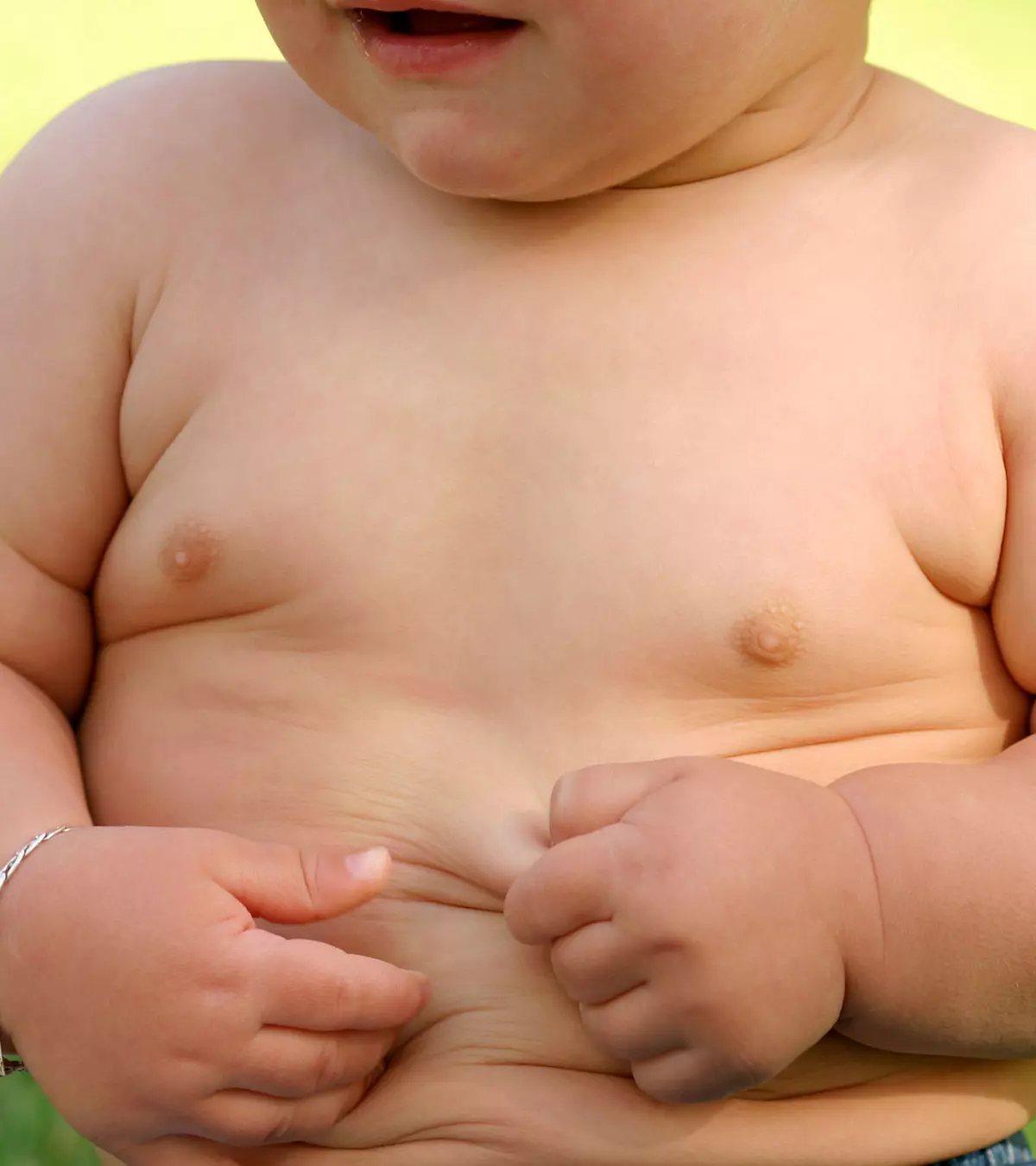
Image: iStock
Babies with a fleshy, roundish appearance look adorable. Besides, these so-called “fat babies” are generally considered healthier than lean and thin babies. However, though the fat gain in babies reflects healthy growth and development, excess fat is not desirable. So how much fat gain in babies is considered excessive? Knowing this is vital as not all babies who look bulky are overweight or obese. Rather, it is normal for most babies to be slightly heavy and plump. Baby fat plays a key role in a baby’s growth and development. It provides energy and supports both physical and brain development. Knowing its importance can help parents recognize the difference between normal weight gain and unhealthy fat levels. Read on to learn about excess fat in babies, when heavier babies are considered healthy and when they are not, and how parents can prevent their babies from gaining excessive weight.

Key Pointers
- Most babies have fat rolls on their bodies, which is not unhealthy.
- The fat helps regulate body temperature and aids in brain development.
- Maternal weight, genetics, or excessive formula feeding are common reasons that contribute to some babies being heavier.
- Encouraging physical activity, avoiding food reinforcement, using smaller feeding bottles, and other ways to manage your baby’s weight are discussed below.
Are “Fat Babies” Healthy?
According to Richard I. Shader, MD, “most adequately nourished newborns have fat rolls on their legs and arms and noticeably short to absent necks (1).” At birth, about 15 percent of the baby’s weight is fat, which is higher than many mammals.
Therefore, babies naturally tend to have a roundish appearance. Most babies who appear plump or flabby are completely healthy, well-fed and their bulkiness may not necessarily indicate an underlying problem, overweight, or obesity.
During the entire first year, most babies gain weight and may become hefty (2). However, some may appear fat, and some may not, depending on their height.
Functions of baby fat
About 95% of baby fat is subcutaneous white fat or subcutaneous white adipose tissue, while the remaining 5% is brown fat or brown adipose tissue. Body fat, especially brown fat, is necessary for babies to support several body functions, such as the regulation of body temperature through insulation. Baby fat also works as an energy reserve facilitating the baby’s rapid brain growth and development (3).
Why Are Some Babies Heavier Than Others?
The birth weight and subsequent weight gain in babies can depend on several factors (4). While some babies are naturally larger due to inherited traits, others may gain weight differently based on factors such as maternal health, feeding practices, and even external influences.
- Genetics: Research shows that parental height and weight can influence the baby’s birth weight and weight gain pattern during infancy (5). Also, women of certain genetic backgrounds may usually give birth to heavier babies.

- Gender: Full-term boys tend to be heavier at birth and gain weight faster than full-term girls. Androgen (a male hormone) activity might be responsible for the occurrence (6).
- Birth order: Evidence suggests that second-born babies are usually heavier than their first-born siblings, although there can be exceptions. Several factors, including changes in gestational age, may cause this weight disparity (7).
- Maternal weight: An overweight or obese pregnant woman could have a higher risk of delivering a heavy baby (8). The baby may also have excess weight gain.
- Maternal health status: Certain maternal health conditions during gestation could lead to a heavier baby at birth. For instance, gestational diabetes may lead to high birth weight and other complications in newborns (9).
- Maternal diet: A woman’s diet during gestation could influence an infant’s birth weight and weight gain pattern. Women who consume excessive trans-fat foods, such as fried foods and baked goods, during pregnancy usually give birth to larger babies. A study report states, “ A higher maternal intake of trans fatty acids, especially 16:1t and 18:2tc, during the second trimester of pregnancy was associated with greater fetal growth (10).”
- Post-term delivery: Babies born after 42 weeks (post-term) of gestation are likely to be larger than those born full-term (11). Very few babies are born after 42 weeks, and the reasons for the pregnancy to be prolonged are unclear (12).
- Excessive formula feeding: Overfeeding a baby with formula or feeding formula in large bottles could lead to weight gain in formula-fed babies (13).

- Inappropriate solid foods: A baby older than six months consumes various solids and drinks. Feeding the baby high-sugar, processed foods, and drinks, such as fruit juices, could cause excess weight. According to the American Academy of Pediatrics’ timeline illustrating behaviors associated with overweight and obesity during infancy, “By 6 months, 80% of families have already introduced juice into the diet; however, 20% of infants will have already been introduced by 4 months (14).” This early introduction of sugary beverages may contribute to unhealthy weight gain and long-term dietary habits.
Some of the other factors that can influence a baby’s birth weight and weight gain are fetal chromosomal abnormalities and multiple births. The intertwining of multiple factors could result in a specific growth trend, causing some babies to become heavier than others.
 Things to know
Things to knowWhat Are The Health Risks Of Excess Weight In Babies?

Several studies note that excess and rapid weight gain during the first two years of life is strongly correlated with overweight and obesity in later life (16) (17). Reports of the National Health and Nutrition Examination Survey show that the prevalence of obesity among children aged two to five years was about 12.7%, in the US (18). Babies constantly gain weight through infancy and toddlerhood. However, weight gain at a rate faster than normal is what usually indicates that the baby is becoming overweight or obese.
Babies with excess weight may find it difficult to balance their neck and maintain posture. They are also likely to experience developmental delays due to a likely delay in attaining developmental milestones, such as crawling and walking (19).
Most risks of excess weight gain can be mitigated through regular monitoring of the baby’s weight. If you feel your baby is gaining too much weight, do not hesitate to talk to a pediatrician.
How To Know If The Baby’s Weight Is A Cause For Concern?

The average birth weight of a full-term, healthy baby can be between 5.5lb (2.5kg) and 10lb (4.5kg) (20). The birth weight of most babies doubles by the fourth or sixth month and triples by the 12th month (21). Throughout this time span, a pediatrician will periodically plot your baby’s weight, height, and head size on a standard growth chart to monitor their growth.
A standard growth chart is an assessment tool that compares a baby’s head size, weight-for-length, length-for-age, and weight-for-age against the standard ranges for babies of the same gender and age (22). If a baby’s weight-for-length is greater than the 98th percentile, they are considered large or heavy (23) (24).
Many babies lose weight by the time they become toddlers. However, if baby fat persists or increases, your doctor will monitor the baby more closely and suggest strategies to regulate weight gain.
Note: Use the World Health Organization’s (WHO) growth charts for monitoring the growth rate of babies under two years of age (22).
How To Keep A Baby At A Healthy Weight?

In most cases, baby fat isn’t a concern, yet keeping your infant’s weight within a healthy range is good for optimal long-term health. Below are some tips that may help keep your baby’s weight on track (25) (26).
- Breastfeed your infant more and for a longer time, which may be beyond 12 months. Breastfeeding reduces your infant’s risk of gaining too much weight.
- Give expressed breast milk to your baby as much as possible if breastfeeding isn’t possible.
- Use smaller bottles to feed your baby as large bottles often lead to overfeeding.
 Quick fact
Quick fact- Do not give a bottle to your baby to self-soothe or fall asleep. Instead, teach babies ways to self-soothe as early as three months of age.
- Avoid adding cereal to thicken the formula unless directed by your pediatrician.
- Follow responsive feeding. Identify your baby’s hunger cues and feed accordingly rather than following a time table.
- Avoid serving processed foods, such as sugary cereals, and beverages, such as packaged juices, to babies. Instead, offer various foods made with fresh fruits, vegetables, grains, pulses, fish, and lean meat.
- Encourage healthy snacking between meals in limited portions. Choose fresh, homemade snacks instead of packaged options, such as biscuits.
- Encourage physical activity in older babies and toddlers by engaging them in active games, such as outdoor games.
- Avoid pacifying babies and toddlers with food. A baby crying doesn’t always mean they are hungry. A baby/toddler cries due to several reasons, such as boredom.
- Avoid food reinforcement in older babies and toddlers. Do not use food as a reward since it may set unhealthy eating habits and lead to overweight and obesity (28).
- Limit or avoid screen time, as too much screen time has been linked to a higher risk of weight gain in young children. The American Academy of Pediatrics advises that babies and children under two should not have any screen time, including TV, computers, and video games (29).
Parents can help babies maintain a healthy weight by monitoring growth charts and looking for signs of rapid weight gain. It’s also important to encourage healthy eating habits early on and create a positive attitude toward food.
Frequently Asked Questions
1. When do babies start to slim down?
Most babies begin to lose their birth weight as they touch the two-year mark. So, you may notice that your child looks slim as they start going to kindergarten (30).
2. Do fatter babies sleep better?
There is no sufficient evidence to prove this claim. On the other hand, a study found that babies who had an uninterrupted sleep at night are less likely to become overweight in the initial six months of life (31).
3. Do preterm babies typically weigh less than full-term babies?
Preterm infants generally have lower birth weights compared to full-term infants. On average, full-term babies weigh approximately 7 pounds (3.17 kg) at birth, whereas premature newborns often weigh 5 pounds (2.26 kg) or less (32).
4. What are the signs that my baby might be gaining too much weight?
Signs of excessive weight gain include rapidly crossing growth percentile curves on standard pediatric growth charts, consistently weighing significantly above the 95th percentile for age and sex, and developing rolls of fat that seem disproportionate.
A round, chubby, and fat appearance are common in babies. Fat plays several vital functions in the normal functioning of their bodies. It is a common misconception that only babies who appear fat, pudgy, or rotund are healthy, but that is not the only parameter. Some babies may appear chubbier than others, and several factors affect them. Babies consistently gain weight through infancy and toddlerhood. A weight gain at a rate faster than usual may need medical attention. Provide your child with healthy and well-balanced meals to ensure healthy weight gain. Do not put your child on a diet plan without a doctor’s consent, as it may cause adverse effects on their growth and development.
Infographic: Reasons Behind Baby’s Chubby Cheeks And Caring For Them
Chubby cheeks in babies are usually due to the deposition of fat and muscles that serve a specific physiological function. Our infographic shares the reasons why babies have chubby cheeks and how parents can care for their cheeks, keeping them soft and supple.
Some thing wrong with infographic shortcode. please verify shortcode syntax
Illustration: Are Fat Babies Healthy And When Is It A Concern?

Image: Stable Diffusion/MomJunction Design Team
This is a short video explaining baby fat and provides tips on nutrition and exercise for a fit and healthy baby.
References:
- Richard I. Shader; (2018); Baby Fat or a Fat Baby?
https://www.clinicaltherapeutics.com/action/showPdf?pii=S0149-2918(18)30421-1 - Baby weight gain: A guide to their first year.
https://www.texaschildrens.org/content/wellness/baby-weight-gain-guide-their-first-year#:~:text=Growth%20rate&text=From%20birth%20to%201%20year,observe%20normal%20growth%20and%20gain. - Fatness at Birth.
https://carta.anthropogeny.org/moca/topics/fatness-birth - Your Newborn’s Growth.
https://kidshealth.org/en/parents/grownewborn.html#:~:text=A%20healthy%20newborn%20is%20expected,(30%20grams)%20per%20day. - Lucy J Griffiths et.al; (2007); Differential parental weight and height contributions to offspring birthweight and weight gain in infancy.
https://pubmed.ncbi.nlm.nih.gov/16984935/ - F de Zegher et.al; (1995); Fetal growth: boys before girls.
https://pubmed.ncbi.nlm.nih.gov/10559673/ - Silvia Bacci et.al; (2014); Differences in Birthweight Outcomes: A Longitudinal Study Based on Siblings.
https://pmc.ncbi.nlm.nih.gov/articles/PMC4076673/ - Obesity and Pregnancy.
https://www.acog.org/womens-health/faqs/obesity-and-pregnancy - Yi Yang et.al; (2018); The association of gestational diabetes mellitus with fetal birth weight.
https://pubmed.ncbi.nlm.nih.gov/29907325/ - Juliana FW Cohen et.al; (2011); Maternal trans fatty acid intake and fetal growth.
https://pmc.ncbi.nlm.nih.gov/articles/PMC3192475/ - Tracking Your Baby’s Weight and Measurements.
https://www.healthychildren.org/English/ages-stages/baby/Pages/Tracking-Your-Babys-Weight-and-Measurements.aspx - When you pass your due date.
https://medlineplus.gov/ency/patientinstructions/000515.htm - Bottle Size and Weight Gain in Formula-Fed Infants.
https://publications.aap.org/pediatrics/article-abstract/138/1/e20154538/52554/Bottle-Size-and-Weight-Gain-in-Formula-Fed-Infants?redirectedFrom=fulltext - Infant Timeline for Overweight and Obesity Behaviors.
https://www.aap.org/en/patient-care/healthy-active-living-for-families/infant-timeline/?srsltid=AfmBOopSJT5De39qCEi7K6avk9OTwDwx9z29RpZ7xZoD1XLfJqK_9ZSY - Madeleine Grigg-Damberger; (2025); Increased risk for excessive weight gain in infants who sleep less than 12 hours per 24 hours.
https://jcsm.aasm.org/doi/10.5664/jcsm.9662 - Jessica Appleton et.al; (2017); Infant formula feeding practices associated with rapid weight gain: A systematic review.
https://onlinelibrary.wiley.com/doi/epdf/10.1111/mcn.12602 - Torill Alise Rotevatn et.al; (2019); Infancy weight gain, parental socioeconomic position, and childhood overweight and obesity: a Danish register-based cohort study.
https://bmcpublichealth.biomedcentral.com/articles/10.1186/s12889-019-7537-z - National Health and Nutrition Examination Survey 2017–March 2025 Prepandemic Data Files — Development of Files and Prevalence Estimates for Selected Health Outcomes.
https://stacks.cdc.gov/view/cdc/106273 - M Jaffe and C Kosakov; (1982); The motor development of fat babies.
https://pubmed.ncbi.nlm.nih.gov/6180859/ - Physical Growth in Newborns.
https://www.uofmhealth.org/health-library/te6295 - Slow Weight Gain in Infants and Children.
https://www.childrenshospital.org/conditions/slow-weight-gain-infants-and-children - WHO growth standards for use in US infants and children birth to 2 years.
https://www.cdc.gov/growthcharts/who-growth-charts.htm?CDC_AA_refVal=https%3A%2F%2Fwww.cdc.gov%2Fgrowthcharts%2Fwho_charts.htm - Growth Charts: What to know.
https://www.cdc.gov/growthcharts/information-for-healthcare-professionals.htm - Infant BMI or Weight-for-Length and Obesity Risk in Early Childhood.
https://publications.aap.org/pediatrics/article-abstract/137/5/e20153492/51999/Infant-BMI-or-Weight-for-Length-and-Obesity-Risk?redirectedFrom=fulltext - 6 ways to help keep your baby at a healthy weight.
https://www.health.harvard.edu/blog/6-ways-to-help-keep-your-baby-at-a-healthy-weight-2017041111575 - Healthy Mom, Healthy Baby: The Risks Of Excess Weight.
https://www.oregon.gov/OHA/PH/PREVENTIONWELLNESS/NUTRITION/Documents/wotn/wotnhealthymomandbaby.pdf - A Chubby Baby is Not a Sign of Future Obesity.
https://www.stanfordchildrens.org/en/topic/default?id=a-chubby-baby-is-not-a-sign-of-future-obesity-1-3034 - Why Parents Shouldn’t Use Food as Reward or Punishment.
https://www.urmc.rochester.edu/encyclopedia/content?ContentTypeID=160&ContentID=32 - Baby Fat or Fat Baby?
https://www.texashealth.org/baby-care/Infancy/baby-fat-or-fat-baby - Steps to Promote a Healthy Weight for Your Toddler.
https://health.clevelandclinic.org/when-should-my-toddler-start-slimming-down - Study finds link between sleep habits and weight gain in newborns.
https://www.nih.gov/news-events/news-releases/study-finds-link-between-sleep-habits-weight-gain-newborns - Caring for a Premature Baby: What Parents Need to Know.
https://www.healthychildren.org/English/ages-stages/baby/preemie/Pages/Caring-For-A-Premature-Baby.aspx
Community Experiences
Join the conversation and become a part of our nurturing community! Share your stories, experiences, and insights to connect with fellow parents.
Read full bio of Dr. Elna Gibson
Read full bio of Swati Patwal
Read full bio of Rohit Garoo
Read full bio of Ghazia Shah
















